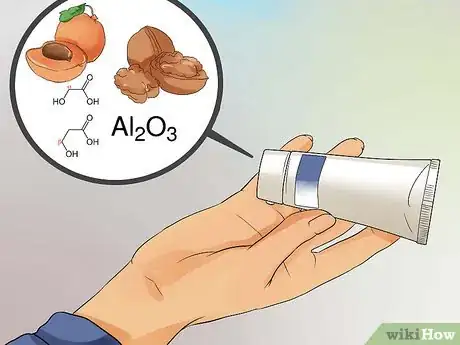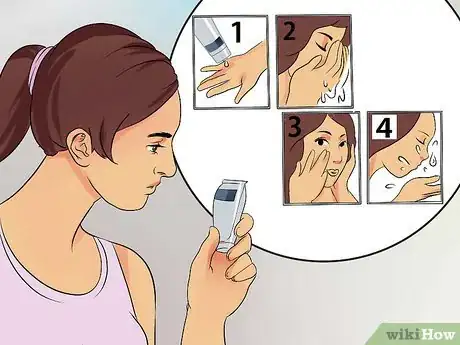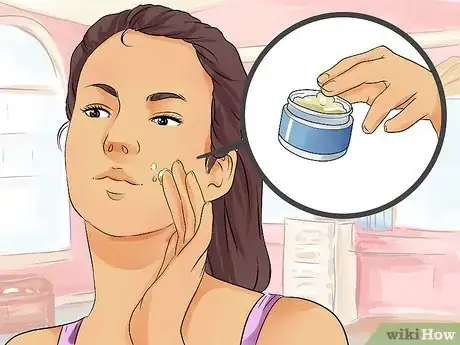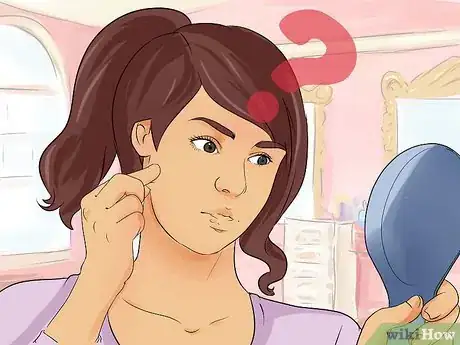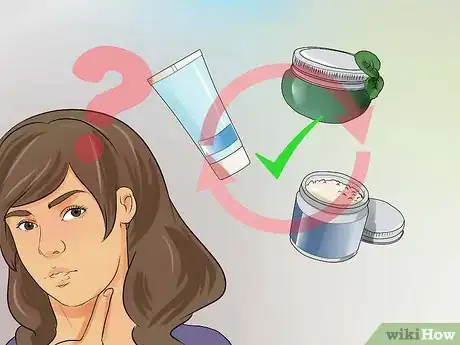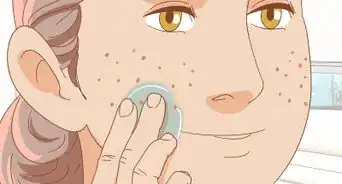This article was co-authored by Carlotta Butler, RN, MPH. Carlotta Butler is a Registered Nurse in Arizona. Carlotta is a member of the American Medical Writers Association. She received her Masters of Public Health from the Northern Illinois University in 2004 and her Masters in Nursing from the University of St. Francis in 2017.
There are 9 references cited in this article, which can be found at the bottom of the page.
wikiHow marks an article as reader-approved once it receives enough positive feedback. This article received 19 testimonials and 95% of readers who voted found it helpful, earning it our reader-approved status.
This article has been viewed 913,677 times.
Using a facial scrub can make your skin feel beautiful, youthful, soft, and like it's glowing. Unlike a regular soap or cleanser, a facial scrub uses small particles, beads, or chemicals to get rid of the old skin cells and make way for new ones in a process known as exfoliation.[1] The process is simple: to use a facial scrub, choose a natural or chemical scrub suited for your skin type, massage the scrub into damp skin for one minute, then rinse and moisturize your skin. Repeat once or twice a week. With all of its benefits, you should consider making a facial scrub a part of your weekly skin care routine.
Steps
Preparing to Use a Facial Scrub
-
1Decide whether or not you should use a facial scrub. Not everyone should exfoliate their skin using a facial scrub. For example, persons with rosacea, warts, inflammatory acne, or herpes might find their conditions exacerbated by exfoliating scrubs. If you have a history of skin problems, you should consult your dermatologist to determine what kind of skin care regime is most appropriate for you. [2]
-
2Determine your skin type. Different kinds of skin will react differently to facial scrubs and other products, and some facial scrubs are designed for your particular skin type. Perhaps you already know whether you have normal, dry, oily, or combination skin. If not, you might want to determine your skin type using a tissue test.
- Wash your face to ensure that there are no products or cosmetics remaining on your skin.
- Allow your face to air-dry and wait at least one hour.
- Dab a tissue to your forehead, nose, chin, cheeks, and temples.
- If the tissue sticks, that is an indication that the skin is oily. If the tissue does not stick, that is an indication that the skin is dry. If your t-zone (forehead, nose, and chin) are oily but the rest of your face is dry, that is an indicator of combination skin.
- Your skin might also be more or less sensitive to skin care products. Usually people with sensitive skin have dry skin or combination skin, but this is not always the case.[3] If your face has reacted poorly to cosmetics or facial products in the past, you might have sensitive skin. Signs of skin sensitivity include redness, uncharacteristic breakouts, bumps, peeling, itchiness, or soreness.[4]
Advertisement -
3Choose the best facial scrub for your skin type. Most commercial facial scrubs will state whether they are appropriate for dry, oily, combination, normal, or sensitive skin. Some facial scrubs will also be appropriate for all skin types. However, there are some general guidelines for matching a facial scrub to your skin type:
-
4Find a good place to store your new facial scrub. Some scrubs can be stored in the shower, which is convenient for your routine. However, some scrubs are more effective if stored in a cool, dry place such as a medicine cabinet, linen closet, or kitchen cupboard. Follow the recommendations of the product label if you are using a commercial scrub. If you are making your own facial scrub, follow the recipe's recommendations.
-
5Read and follow all instructions for using the facial scrub. Pay particular attention to product warnings, expiration dates, possible allergens, or adverse interactions with other facial products. Some facial scrubs are meant solely for exfoliating but do not cleanse the skin, which means you have to wash your face before using the scrub in order for it to be effective.
Washing Your Face with a Facial Scrub
-
1Use warm water to wet your skin. If you have long hair, you should pull it back into a ponytail or bun so that it doesn't get in the way. Make sure you moisten your entire face. It is best to use warm water, but avoid using water that is too hot: that can dry out your skin.[7]
-
2Massage your skin gently with the facial scrub for one minute. Take a dab of the scrub and massage it all over your face and neck. Be careful not to rub too hard, so that you can avoid unnecessary redness or peeling. Also be particularly careful not to get the scrub in your eyes.
- Note that rubbing for more than 60-90 seconds might cause irritation or sensitivity. Be sure that you are not over-scrubbing or leaving the scrub on your face for too long.
-
3Rinse the scrub off your face. Make sure you get it all off. When you rinse all of it off, your skin will feel very smooth and soft.
-
4Dry your skin. Gently pat your skin dry with a soft towel and continue with the rest of your skin care routine.
-
5Moisturize your skin. Even if you have oily or combination skin, moisturizing is a necessary part of a skin care routine, especially after exfoliating with a facial scrub. Moisturizing helps to prevent the overproduction of skin oils and keeps the skin healthy and well-balanced.[8]
-
6Use the scrub only once or twice per week. It might be tempting to get that soft, glowing feeling every morning. However, using a facial scrub too often can peel away your delicate skin cells and leave you feeling red, raw, and sore. Try using the scrub only once a week at first; you can increase the frequency to twice a week if you feel like your skin can handle it.[9] [10] Moderation is key to the effectiveness of a facial scrub.
Observing the Results of a Facial Scrub
-
1Pay close attention to your skin for the next few weeks. If the scrub is effective, you should begin seeing signs of softer, smoother, more youthful skin fairly quickly. In which case, congratulations! You have uncovered the best product for exfoliating your skin.
-
2Watch for signs of redness, itching, or rash. These are indications of an allergy or sensitivity. If you experience these symptoms, you should discontinue use of this particular scrub immediately and select an alternative product. You might also consider asking your dermatologist to conduct a patch test to determine what exactly you might be allergic or sensitive to. [11]
-
3Try out a different scrub if you are unhappy with your first attempt. It might take a few tries in order for you to find the ideal product for your skin type. Remember to be patient and watchful. You will find a good match eventually!
Expert Q&A
-
QuestionCan I apply scrub around my eyes?
 Laura MartinLaura Martin is a Licensed Cosmetologist in Georgia. She has been a hair stylist since 2007 and a cosmetology teacher since 2013.
Laura MartinLaura Martin is a Licensed Cosmetologist in Georgia. She has been a hair stylist since 2007 and a cosmetology teacher since 2013.
Licensed Cosmetologist Don't! The area around your eyes is too sensitive for a scrub.
Don't! The area around your eyes is too sensitive for a scrub. -
QuestionShould I use the facial scrub in the morning and evening?
 Laura MartinLaura Martin is a Licensed Cosmetologist in Georgia. She has been a hair stylist since 2007 and a cosmetology teacher since 2013.
Laura MartinLaura Martin is a Licensed Cosmetologist in Georgia. She has been a hair stylist since 2007 and a cosmetology teacher since 2013.
Licensed Cosmetologist You can use a scrub either in the morning or evening, but should not use it more than a few times a week.
You can use a scrub either in the morning or evening, but should not use it more than a few times a week.
Warnings
- Avoid scrubbing around the eyes.⧼thumbs_response⧽
- Don't scrub too hard or too long or you might damage or redden your skin.⧼thumbs_response⧽
- Don't scrub your face more than once or twice a week.⧼thumbs_response⧽
- Pay attention to all package warnings and instructions: some facial scrubs interact poorly with other products.⧼thumbs_response⧽
- Discontinue use and consult your dermatologist if you experience signs of allergy or extreme sensitivity.⧼thumbs_response⧽
References
- ↑ https://www.aad.org/stories-and-news/news-releases/evaluate-before-you-exfoliate
- ↑ https://www.aad.org/stories-and-news/news-releases/evaluate-before-you-exfoliate
- ↑ http://www.ncbi.nlm.nih.gov/pubmed/21781068
- ↑ http://dermnetnz.org/reactions/sensitive-skin.html
- ↑ http://www.thedermreview.com/facial-scrub/
- ↑ http://www.thedermreview.com/facial-scrub/
- ↑ https://www.aad.org/dermatology-a-to-z/diseases-and-treatments/a---d/dry-skin/tips
- ↑ http://www.thedermreview.com/how-to-exfoliate-the-face/
- ↑ https://www.aad.org/media/news-releases/evaluate-before-you-exfoliate
About This Article
To use a facial scrub, choose the right scrub for your skin type, which might be oily, combination, normal, dry, or sensitive. Read the directions on the package, and use warm water to wet your skin. Then, massage the product into your skin for 60-90 seconds, and then rinse your skin with warm water. Use a soft towel to pat your skin dry, and apply a moisturizer all over your face. For tips on selecting a moisturizer and making sure the moisturizer is working for your skin, keep reading!


